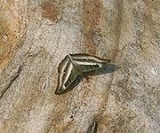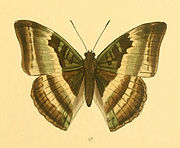
Auzakia danava
Encyclopedia
The Commodore is a species of nymphalid
butterfly found in tropical and subtropical Asia.
 Upperside of male is fuliginous brown, paling on the terminal half of the wings. Fore wing has the basal area below the cell, two broad bands across the latter, and a patch beyond its apex to cost a dark brownish black, the outer margin of the dark area crenulate, extended angularly along the veins ; this is followed by a pale olive-brown obscure band, a discal dark brown band widening below costa, and a subterminal narrower band of the same shade; between discal and subterminal bands is a series of faintly defined dark transverse spots in the interspaces- Hind wing: basal third dark brown, followed by a pale olive-brown interspace; discal, postdiscal and subterminal bands as on the fore wing; tornus suffused with green. Underside pale ochraceous, suffused with lilacine ; cell of fore wing crossed by a medial and an apical brighter lilac band bordered with dark lines on both sides ; base and cell of hind wing with the usual loop-like slender dark marks with pale centres; a lilac discal band, lunular and curved inwards anteriorly on the fore wing, broad and straight on the hind wing, followed on both wings by a yellow postdiscal diffuse narrow band. Fore wing with a patch of purplish white on apex: hind wing with a broad transverse subterminal diffuse lilac band traversed by a series of lunular obscure brownish marks; termen of both fore and hind wing brownish yellow. Antennae, head, thorax and abdomen dark brown; beneath, the palpi, thorax and abdomen pale lilacine white.
Upperside of male is fuliginous brown, paling on the terminal half of the wings. Fore wing has the basal area below the cell, two broad bands across the latter, and a patch beyond its apex to cost a dark brownish black, the outer margin of the dark area crenulate, extended angularly along the veins ; this is followed by a pale olive-brown obscure band, a discal dark brown band widening below costa, and a subterminal narrower band of the same shade; between discal and subterminal bands is a series of faintly defined dark transverse spots in the interspaces- Hind wing: basal third dark brown, followed by a pale olive-brown interspace; discal, postdiscal and subterminal bands as on the fore wing; tornus suffused with green. Underside pale ochraceous, suffused with lilacine ; cell of fore wing crossed by a medial and an apical brighter lilac band bordered with dark lines on both sides ; base and cell of hind wing with the usual loop-like slender dark marks with pale centres; a lilac discal band, lunular and curved inwards anteriorly on the fore wing, broad and straight on the hind wing, followed on both wings by a yellow postdiscal diffuse narrow band. Fore wing with a patch of purplish white on apex: hind wing with a broad transverse subterminal diffuse lilac band traversed by a series of lunular obscure brownish marks; termen of both fore and hind wing brownish yellow. Antennae, head, thorax and abdomen dark brown; beneath, the palpi, thorax and abdomen pale lilacine white.
Female has the upperside similar to that of the male, but fore and hind wings crossed obliquely by broad, outwardly somewhat diffuse, prominent white discal and postdiscal bands. These bands slightly tinged with fuliginous and on the fore wing somewhat lunular. The postdiscal band on both fore and hind wing outwardly traversed by a series of detached dark lunules ; the dark interspace between the two bands much paler, suffused with green on its inner half. Underside as in the male but very much paler; the series of postdiscal detached lunules as on the upperside.
Nymphalidae
The Nymphalidae is a family of about 5,000 species of butterflies which are distributed throughout most of the world. These are usually medium sized to large butterflies. Most species have a reduced pair of forelegs and many hold their colourful wings flat when resting. They are also called...
butterfly found in tropical and subtropical Asia.
Description
- See glossaryGlossary of Lepidopteran termsThis glossary describes the terms used in the formal descriptions of insect species, jargon used mostly by professionals or entomologist....
for terms used

Female has the upperside similar to that of the male, but fore and hind wings crossed obliquely by broad, outwardly somewhat diffuse, prominent white discal and postdiscal bands. These bands slightly tinged with fuliginous and on the fore wing somewhat lunular. The postdiscal band on both fore and hind wing outwardly traversed by a series of detached dark lunules ; the dark interspace between the two bands much paler, suffused with green on its inner half. Underside as in the male but very much paler; the series of postdiscal detached lunules as on the upperside.

